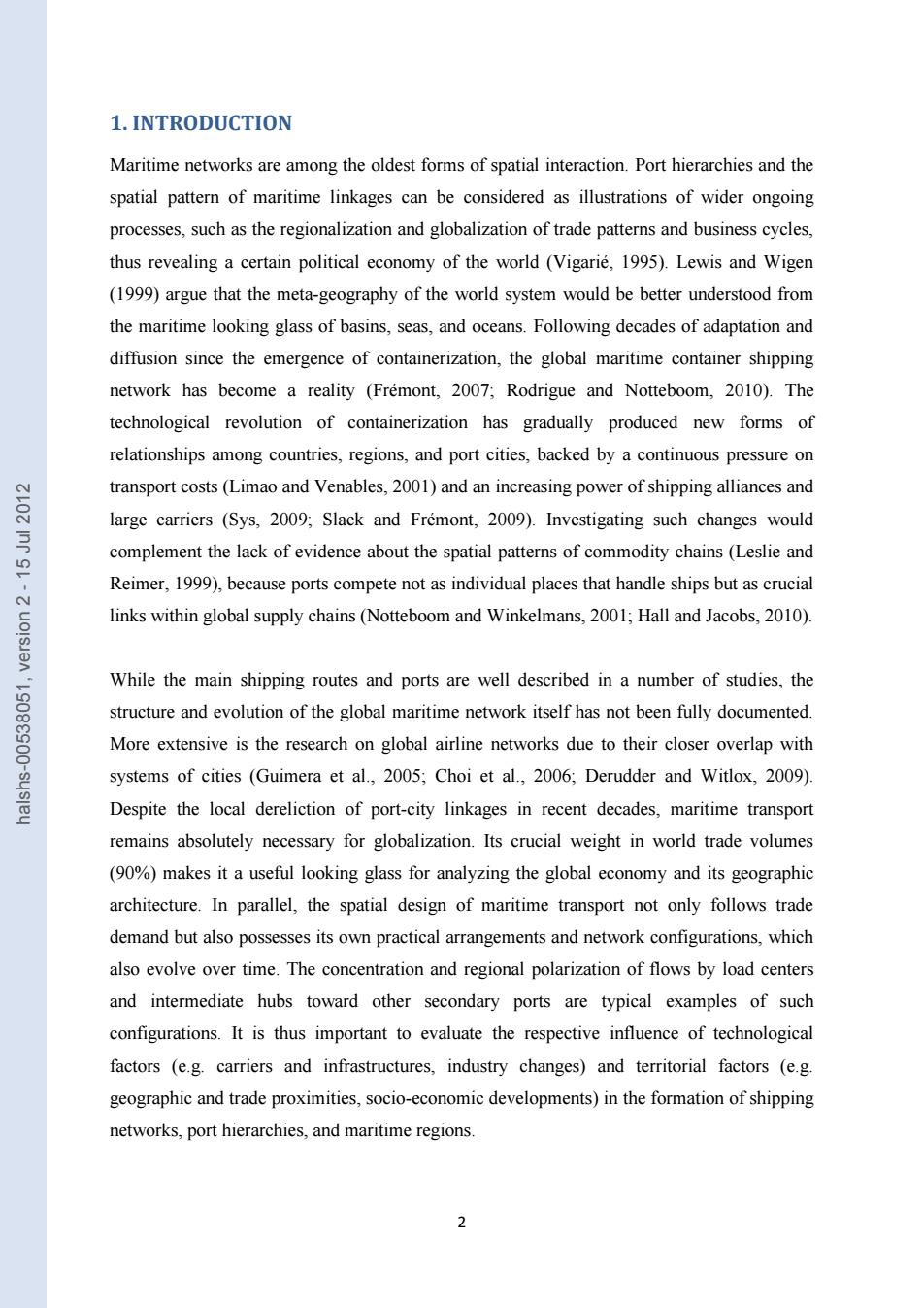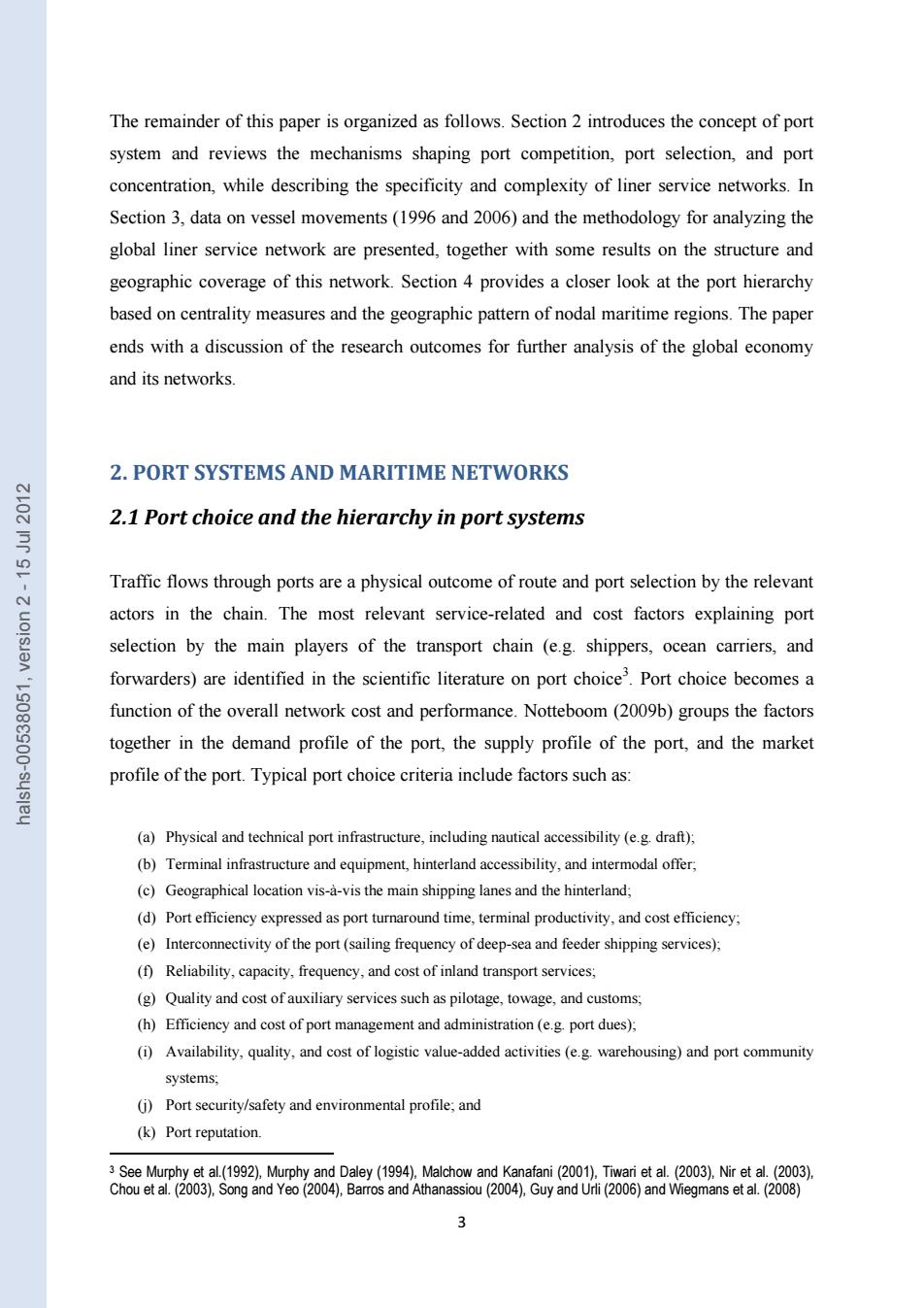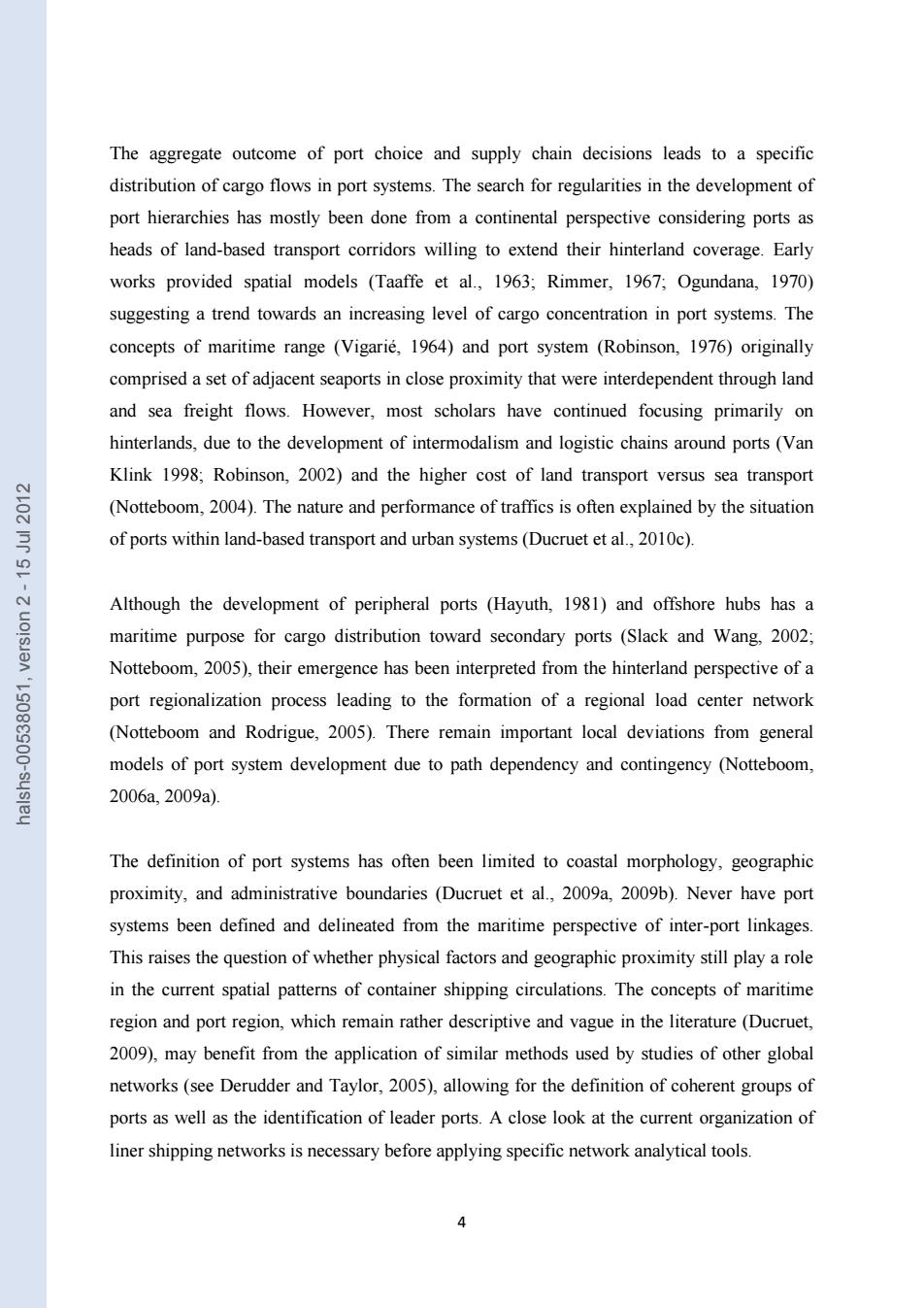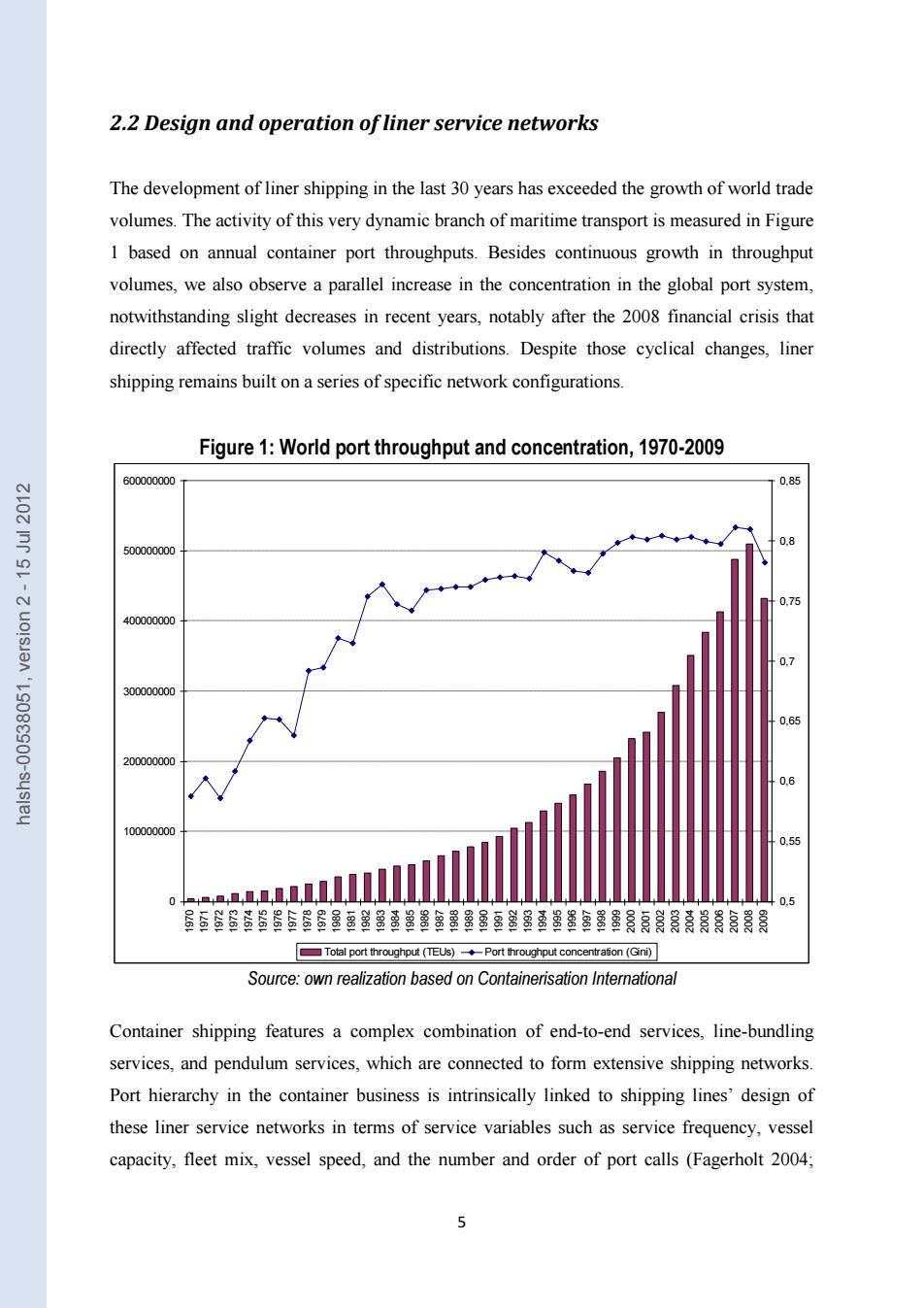
Author manuscript,published in "Global Networks 12,3(2012)395-423" D01:10.1111j.1471-0374.2011.00355.× THE WORLDWIDE MARITIME NETWORK OF CONTAINER SHIPPING: SPATIAL STRUCTURE AND REGIONAL DYNAMICS Cesar DUCRUET Theo NOTTEBOOM2 ABSTRACT Port and maritime studies dealing with containerization have observed traffic concentration and dispersion throughout the world.Globalization,intermodal transportation,and 点 technological revolutions in the shipping industry have resulted in both network extension and 3 rationalization.However,lack of precise data on inter-port relations prevent the application of wider network theories to global maritime container networks,which are often examined N through case studies of specific firms or regions.This paper presents an analysis of the global 西 liner shipping network in 1996 and 2006,a period of rapid change in port hierarchies and liner service configurations.While it refers to literature on port system development,shipping networks,and port selection,it is one of the only analyses of the properties of the global container shipping network.The paper analyzes the relative position of ports in the global -sus] network through indicators of centrality.The results reveal a certain level of robustness in the global shipping network.While transhipment hub flows and gateway flows might slightly shift among nodes in the network,the network properties remain rather stable in terms of the main nodes polarizing the network and the overall structure of the system.Additionally, mapping the changing centrality of ports confirms the impacts of global trade and logistics shifts on the port hierarchy and indicates that changes are predominantly geographic. Keywords:liner shipping,network analysis,nodal regions,port hierarchy,spatial change 1 Corresponding author:French National Centre for Scientific Research(CNRS).UMR 8504 Geographie-cites,Equipe P.A.Rl.S.,13 rue du Four,,F-75006 Paris,.France..Tel.+33(0)140-464-007,Mobile+33(0)626-602-163,Fax+33(0)140-464- 009.Email:ducruet@parisgeo.cnrs.fr 2 ITMMA/University of Antwerp and Antwerp Maritime Academy,Kipdorp 59,B-2000 Antwerp,Belgium;Phone:+32- 32655152,Fax:+32-32655150,Email:theo.notteboom@ua.ac.be
1 THE WORLDWIDE MARITIME NETWORK OF CONTAINER SHIPPING: SPATIAL STRUCTURE AND REGIONAL DYNAMICS César DUCRUET1 Theo NOTTEBOOM2 ABSTRACT Port and maritime studies dealing with containerization have observed traffic concentration and dispersion throughout the world. Globalization, intermodal transportation, and technological revolutions in the shipping industry have resulted in both network extension and rationalization. However, lack of precise data on inter-port relations prevent the application of wider network theories to global maritime container networks, which are often examined through case studies of specific firms or regions. This paper presents an analysis of the global liner shipping network in 1996 and 2006, a period of rapid change in port hierarchies and liner service configurations. While it refers to literature on port system development, shipping networks, and port selection, it is one of the only analyses of the properties of the global container shipping network. The paper analyzes the relative position of ports in the global network through indicators of centrality. The results reveal a certain level of robustness in the global shipping network. While transhipment hub flows and gateway flows might slightly shift among nodes in the network, the network properties remain rather stable in terms of the main nodes polarizing the network and the overall structure of the system. Additionally, mapping the changing centrality of ports confirms the impacts of global trade and logistics shifts on the port hierarchy and indicates that changes are predominantly geographic. Keywords: liner shipping, network analysis, nodal regions, port hierarchy, spatial change 1 Corresponding author: French National Centre for Scientific Research (CNRS), UMR 8504 Géographie-cités, Equipe P.A.R.I.S., 13 rue du Four, F-75006 Paris, France. Tel. +33 (0)140-464-007, Mobile +33(0)626-602-163, Fax +33(0)140-464- 009. Email : ducruet@parisgeo.cnrs.fr 2 ITMMA / University of Antwerp and Antwerp Maritime Academy, Kipdorp 59, B-2000 Antwerp, Belgium; Phone: +32- 32655152, Fax: +32-32655150, Email: theo.notteboom@ua.ac.be halshs-00538051, version 2 - 15 Jul 2012 Author manuscript, published in "Global Networks 12, 3 (2012) 395-423" DOI : 10.1111/j.1471-0374.2011.00355.x

1.INTRODUCTION Maritime networks are among the oldest forms of spatial interaction.Port hierarchies and the spatial pattern of maritime linkages can be considered as illustrations of wider ongoing processes,such as the regionalization and globalization of trade patterns and business cycles, thus revealing a certain political economy of the world (Vigarie,1995).Lewis and Wigen (1999)argue that the meta-geography of the world system would be better understood from the maritime looking glass of basins,seas,and oceans.Following decades of adaptation and diffusion since the emergence of containerization,the global maritime container shipping network has become a reality (Fremont,2007;Rodrigue and Notteboom,2010).The technological revolution of containerization has gradually produced new forms of relationships among countries,regions,and port cities,backed by a continuous pressure on transport costs(Limao and Venables,2001)and an increasing power of shipping alliances and 点 large carriers (Sys,2009;Slack and Fremont,2009).Investigating such changes would 三 complement the lack of evidence about the spatial patterns of commodity chains(Leslie and Reimer,1999),because ports compete not as individual places that handle ships but as crucial N links within global supply chains(Notteboom and Winkelmans,2001;Hall and Jacobs,2010). 西 While the main shipping routes and ports are well described in a number of studies,the structure and evolution of the global maritime network itself has not been fully documented. More extensive is the research on global airline networks due to their closer overlap with -sus] systems of cities (Guimera et al.,2005;Choi et al.,2006;Derudder and Witlox,2009). 巴 Despite the local dereliction of port-city linkages in recent decades,maritime transport remains absolutely necessary for globalization.Its crucial weight in world trade volumes (90%)makes it a useful looking glass for analyzing the global economy and its geographic architecture.In parallel,the spatial design of maritime transport not only follows trade demand but also possesses its own practical arrangements and network configurations,which also evolve over time.The concentration and regional polarization of flows by load centers and intermediate hubs toward other secondary ports are typical examples of such configurations.It is thus important to evaluate the respective influence of technological factors (e.g.carriers and infrastructures,industry changes)and territorial factors (e.g. geographic and trade proximities,socio-economic developments)in the formation of shipping networks,port hierarchies,and maritime regions. 2
2 1. INTRODUCTION Maritime networks are among the oldest forms of spatial interaction. Port hierarchies and the spatial pattern of maritime linkages can be considered as illustrations of wider ongoing processes, such as the regionalization and globalization of trade patterns and business cycles, thus revealing a certain political economy of the world (Vigarié, 1995). Lewis and Wigen (1999) argue that the meta-geography of the world system would be better understood from the maritime looking glass of basins, seas, and oceans. Following decades of adaptation and diffusion since the emergence of containerization, the global maritime container shipping network has become a reality (Frémont, 2007; Rodrigue and Notteboom, 2010). The technological revolution of containerization has gradually produced new forms of relationships among countries, regions, and port cities, backed by a continuous pressure on transport costs (Limao and Venables, 2001) and an increasing power of shipping alliances and large carriers (Sys, 2009; Slack and Frémont, 2009). Investigating such changes would complement the lack of evidence about the spatial patterns of commodity chains (Leslie and Reimer, 1999), because ports compete not as individual places that handle ships but as crucial links within global supply chains (Notteboom and Winkelmans, 2001; Hall and Jacobs, 2010). While the main shipping routes and ports are well described in a number of studies, the structure and evolution of the global maritime network itself has not been fully documented. More extensive is the research on global airline networks due to their closer overlap with systems of cities (Guimera et al., 2005; Choi et al., 2006; Derudder and Witlox, 2009). Despite the local dereliction of port-city linkages in recent decades, maritime transport remains absolutely necessary for globalization. Its crucial weight in world trade volumes (90%) makes it a useful looking glass for analyzing the global economy and its geographic architecture. In parallel, the spatial design of maritime transport not only follows trade demand but also possesses its own practical arrangements and network configurations, which also evolve over time. The concentration and regional polarization of flows by load centers and intermediate hubs toward other secondary ports are typical examples of such configurations. It is thus important to evaluate the respective influence of technological factors (e.g. carriers and infrastructures, industry changes) and territorial factors (e.g. geographic and trade proximities, socio-economic developments) in the formation of shipping networks, port hierarchies, and maritime regions. halshs-00538051, version 2 - 15 Jul 2012

The remainder of this paper is organized as follows.Section 2 introduces the concept of port system and reviews the mechanisms shaping port competition,port selection,and port concentration,while describing the specificity and complexity of liner service networks.In Section 3,data on vessel movements (1996 and 2006)and the methodology for analyzing the global liner service network are presented,together with some results on the structure and geographic coverage of this network.Section 4 provides a closer look at the port hierarchy based on centrality measures and the geographic pattern of nodal maritime regions.The paper ends with a discussion of the research outcomes for further analysis of the global economy and its networks. 2.PORT SYSTEMS AND MARITIME NETWORKS N 点 2.1 Port choice and the hierarchy in port systems Traffic flows through ports are a physical outcome of route and port selection by the relevant N actors in the chain.The most relevant service-related and cost factors explaining port 西 selection by the main players of the transport chain (e.g.shippers,ocean carriers,and forwarders)are identified in the scientific literature on port choice Port choice becomes a function of the overall network cost and performance.Notteboom(2009b)groups the factors together in the demand profile of the port,the supply profile of the port,and the market profile of the port.Typical port choice criteria include factors such as: (a)Physical and technical port infrastructure,including nautical accessibility(e.g.draft); (b)Terminal infrastructure and equipment,hinterland accessibility,and intermodal offer, (c)Geographical location vis-a-vis the main shipping lanes and the hinterland; (d)Port efficiency expressed as port turnaround time,terminal productivity,and cost efficiency; (e)Interconnectivity of the port(sailing frequency of deep-sea and feeder shipping services); (f)Reliability,capacity,frequency,and cost of inland transport services; (g)Quality and cost of auxiliary services such as pilotage,towage,and customs; (h)Efficiency and cost of port management and administration(e.g.port dues); (i)Availability,quality,and cost of logistic value-added activities(e.g.warehousing)and port community systems; (j)Port security/safety and environmental profile;and (k)Port reputation. 3 See Murphy et al(1992),Murphy and Daley(1994).Malchow and Kanafani(2001),Tiwari et al.(2003),Nir et al.(2003). Chou et al.(2003).Song and Yeo(2004).Barros and Athanassiou(2004).Guy and Urli(2006)and Wiegmans et al.(2008)
3 The remainder of this paper is organized as follows. Section 2 introduces the concept of port system and reviews the mechanisms shaping port competition, port selection, and port concentration, while describing the specificity and complexity of liner service networks. In Section 3, data on vessel movements (1996 and 2006) and the methodology for analyzing the global liner service network are presented, together with some results on the structure and geographic coverage of this network. Section 4 provides a closer look at the port hierarchy based on centrality measures and the geographic pattern of nodal maritime regions. The paper ends with a discussion of the research outcomes for further analysis of the global economy and its networks. 2. PORT SYSTEMS AND MARITIME NETWORKS 2.1 Port choice and the hierarchy in port systems Traffic flows through ports are a physical outcome of route and port selection by the relevant actors in the chain. The most relevant service-related and cost factors explaining port selection by the main players of the transport chain (e.g. shippers, ocean carriers, and forwarders) are identified in the scientific literature on port choice3 . Port choice becomes a function of the overall network cost and performance. Notteboom (2009b) groups the factors together in the demand profile of the port, the supply profile of the port, and the market profile of the port. Typical port choice criteria include factors such as: (a) Physical and technical port infrastructure, including nautical accessibility (e.g. draft); (b) Terminal infrastructure and equipment, hinterland accessibility, and intermodal offer; (c) Geographical location vis-à-vis the main shipping lanes and the hinterland; (d) Port efficiency expressed as port turnaround time, terminal productivity, and cost efficiency; (e) Interconnectivity of the port (sailing frequency of deep-sea and feeder shipping services); (f) Reliability, capacity, frequency, and cost of inland transport services; (g) Quality and cost of auxiliary services such as pilotage, towage, and customs; (h) Efficiency and cost of port management and administration (e.g. port dues); (i) Availability, quality, and cost of logistic value-added activities (e.g. warehousing) and port community systems; (j) Port security/safety and environmental profile; and (k) Port reputation. 3 See Murphy et al.(1992), Murphy and Daley (1994), Malchow and Kanafani (2001), Tiwari et al. (2003), Nir et al. (2003), Chou et al. (2003), Song and Yeo (2004), Barros and Athanassiou (2004), Guy and Urli (2006) and Wiegmans et al. (2008) halshs-00538051, version 2 - 15 Jul 2012

The aggregate outcome of port choice and supply chain decisions leads to a specific distribution of cargo flows in port systems.The search for regularities in the development of port hierarchies has mostly been done from a continental perspective considering ports as heads of land-based transport corridors willing to extend their hinterland coverage.Early works provided spatial models (Taaffe et al.,1963;Rimmer,1967;Ogundana,1970) suggesting a trend towards an increasing level of cargo concentration in port systems.The concepts of maritime range (Vigarie,1964)and port system (Robinson,1976)originally comprised a set of adjacent seaports in close proximity that were interdependent through land and sea freight flows.However,most scholars have continued focusing primarily on hinterlands,due to the development of intermodalism and logistic chains around ports (Van Klink 1998;Robinson,2002)and the higher cost of land transport versus sea transport 点 (Notteboom,2004).The nature and performance of traffics is often explained by the situation 三 of ports within land-based transport and urban systems(Ducruet et al.,2010c). N Although the development of peripheral ports(Hayuth,1981)and offshore hubs has a 西 maritime purpose for cargo distribution toward secondary ports (Slack and Wang,2002; Notteboom,2005),their emergence has been interpreted from the hinterland perspective of a port regionalization process leading to the formation of a regional load center network (Notteboom and Rodrigue,2005).There remain important local deviations from general models of port system development due to path dependency and contingency (Notteboom, -sus] 2006a,2009a) 巴 The definition of port systems has often been limited to coastal morphology,geographic proximity,and administrative boundaries (Ducruet et al.,2009a,2009b).Never have port systems been defined and delineated from the maritime perspective of inter-port linkages. This raises the question of whether physical factors and geographic proximity still play a role in the current spatial patterns of container shipping circulations.The concepts of maritime region and port region,which remain rather descriptive and vague in the literature (Ducruet, 2009),may benefit from the application of similar methods used by studies of other global networks(see Derudder and Taylor,2005),allowing for the definition of coherent groups of ports as well as the identification of leader ports.A close look at the current organization of liner shipping networks is necessary before applying specific network analytical tools
4 The aggregate outcome of port choice and supply chain decisions leads to a specific distribution of cargo flows in port systems. The search for regularities in the development of port hierarchies has mostly been done from a continental perspective considering ports as heads of land-based transport corridors willing to extend their hinterland coverage. Early works provided spatial models (Taaffe et al., 1963; Rimmer, 1967; Ogundana, 1970) suggesting a trend towards an increasing level of cargo concentration in port systems. The concepts of maritime range (Vigarié, 1964) and port system (Robinson, 1976) originally comprised a set of adjacent seaports in close proximity that were interdependent through land and sea freight flows. However, most scholars have continued focusing primarily on hinterlands, due to the development of intermodalism and logistic chains around ports (Van Klink 1998; Robinson, 2002) and the higher cost of land transport versus sea transport (Notteboom, 2004). The nature and performance of traffics is often explained by the situation of ports within land-based transport and urban systems (Ducruet et al., 2010c). Although the development of peripheral ports (Hayuth, 1981) and offshore hubs has a maritime purpose for cargo distribution toward secondary ports (Slack and Wang, 2002; Notteboom, 2005), their emergence has been interpreted from the hinterland perspective of a port regionalization process leading to the formation of a regional load center network (Notteboom and Rodrigue, 2005). There remain important local deviations from general models of port system development due to path dependency and contingency (Notteboom, 2006a, 2009a). The definition of port systems has often been limited to coastal morphology, geographic proximity, and administrative boundaries (Ducruet et al., 2009a, 2009b). Never have port systems been defined and delineated from the maritime perspective of inter-port linkages. This raises the question of whether physical factors and geographic proximity still play a role in the current spatial patterns of container shipping circulations. The concepts of maritime region and port region, which remain rather descriptive and vague in the literature (Ducruet, 2009), may benefit from the application of similar methods used by studies of other global networks (see Derudder and Taylor, 2005), allowing for the definition of coherent groups of ports as well as the identification of leader ports. A close look at the current organization of liner shipping networks is necessary before applying specific network analytical tools. halshs-00538051, version 2 - 15 Jul 2012

2.2 Design and operation of liner service networks The development of liner shipping in the last 30 years has exceeded the growth of world trade volumes.The activity of this very dynamic branch of maritime transport is measured in Figure 1 based on annual container port throughputs.Besides continuous growth in throughput volumes,we also observe a parallel increase in the concentration in the global port system, notwithstanding slight decreases in recent years,notably after the 2008 financial crisis that directly affected traffic volumes and distributions.Despite those cyclical changes,liner shipping remains built on a series of specific network configurations. Figure 1:World port throughput and concentration,1970-2009 600000000 0.85 点 0.8 500000000 N 0.75 400000000 01 300000000 0,65 200000000 0.6 100000000 0.55 oBBLLL1 05 金品品品6品虽留显墨鼠墨虽多虽多显墨多墨气餐?晨气胃 Total port throughput (TEUs)Port throughput concentration(Gini) Source:own realization based on Containerisation International Container shipping features a complex combination of end-to-end services,line-bundling services,and pendulum services,which are connected to form extensive shipping networks. Port hierarchy in the container business is intrinsically linked to shipping lines'design of these liner service networks in terms of service variables such as service frequency,vessel capacity,fleet mix,vessel speed,and the number and order of port calls (Fagerholt 2004;
5 2.2 Design and operation of liner service networks The development of liner shipping in the last 30 years has exceeded the growth of world trade volumes. The activity of this very dynamic branch of maritime transport is measured in Figure 1 based on annual container port throughputs. Besides continuous growth in throughput volumes, we also observe a parallel increase in the concentration in the global port system, notwithstanding slight decreases in recent years, notably after the 2008 financial crisis that directly affected traffic volumes and distributions. Despite those cyclical changes, liner shipping remains built on a series of specific network configurations. Figure 1: World port throughput and concentration, 1970-2009 0 100000000 200000000 300000000 400000000 500000000 600000000 1970 1971 1972 1973 1974 1975 1976 1977 1978 1979 1980 1981 1982 1983 1984 1985 1986 1987 1988 1989 1990 1991 1992 1993 1994 1995 1996 1997 1998 1999 2000 2001 2002 2003 2004 2005 2006 2007 2008 2009 0,5 0,55 0,6 0,65 0,7 0,75 0,8 0,85 Total port throughput (TEUs) Port throughput concentration (Gini) Source: own realization based on Containerisation International Container shipping features a complex combination of end-to-end services, line-bundling services, and pendulum services, which are connected to form extensive shipping networks. Port hierarchy in the container business is intrinsically linked to shipping lines’ design of these liner service networks in terms of service variables such as service frequency, vessel capacity, fleet mix, vessel speed, and the number and order of port calls (Fagerholt 2004; halshs-00538051, version 2 - 15 Jul 2012